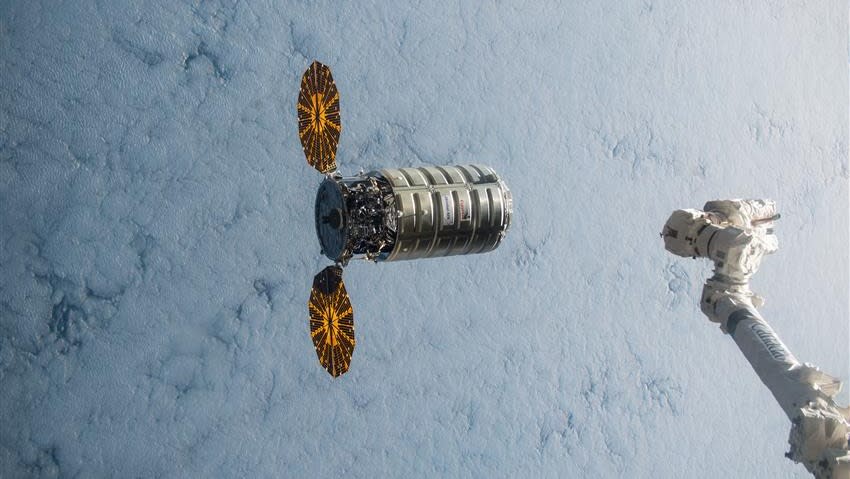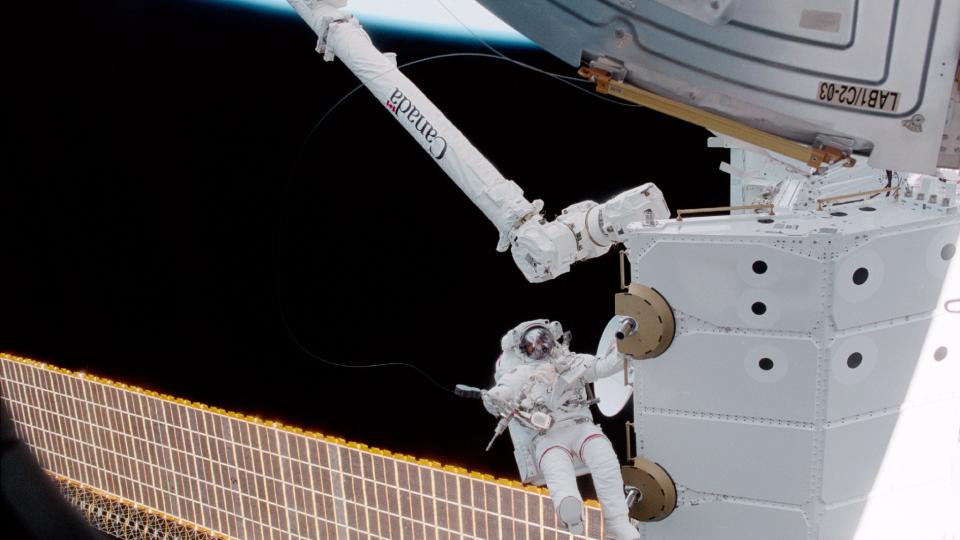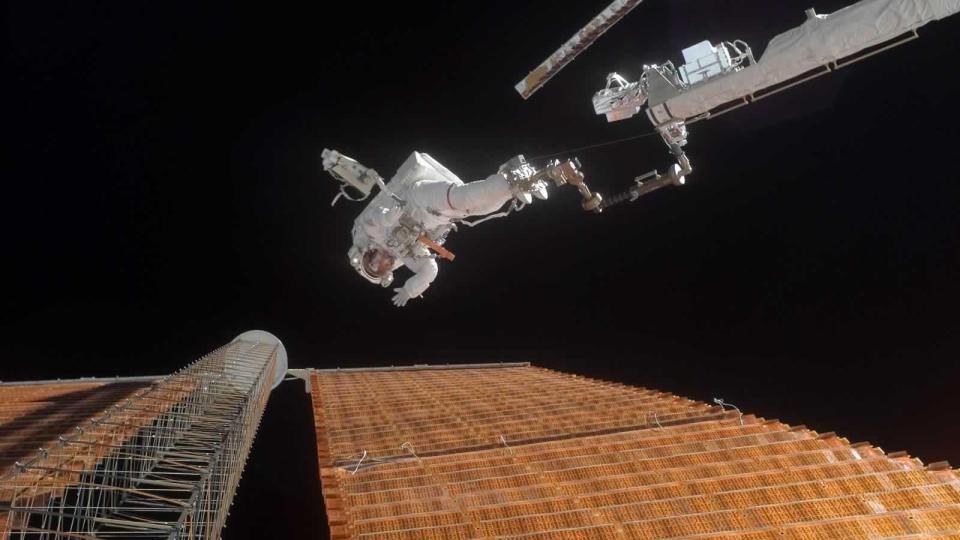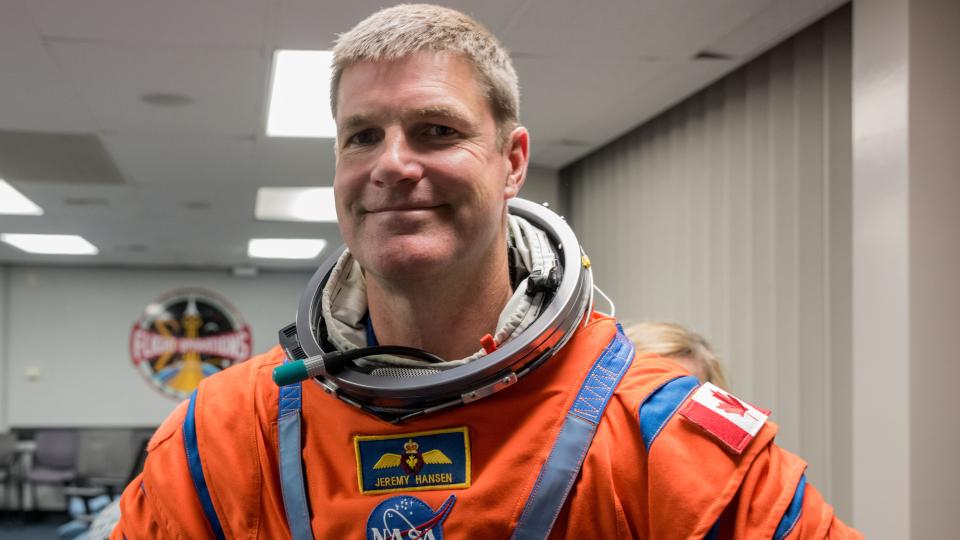When you buy through links in our articles, Future and its syndication partners may earn a commission.

A Canadian robotic arm on the International Space Station is just days away from a major milestone.
The Canadian Space Agency (CSA) announced today (August 2) that the Canadian space agency’s Canadarm2 will celebrate its 50th cosmic capture no earlier than August 5, when a Northrop Grumman Cygnus cargo ship docks with the International Space Station (ISS) carrying thousands of pounds of experiments, supplies and food for the Expedition 71 astronauts.
Cygnus is scheduled to launch to the ISS no earlier than 11:29 a.m. EDT (03:29 GMT) on August 3, and you can watch the mission here on Space.com, courtesy of NASA+, formerly NASA Television. If Cygnus launches on time, it will be captured by Canadarm2 and dock with the ISS at approximately 3:55 a.m. EDT (07:55 GMT) on August 5. Coverage begins at 2:30 a.m. EDT (06:30 GMT) on NASA+.
Canadarm2, operated by MDA Space with CSA funding, was first launched into space on April 19, 2001 during Space Shuttle mission STS-100. Mission astronaut Chris Hadfield performed the first-ever CSA spacewalk to install the arm, a milestone celebrated by playing the Canadian national anthem in space and jokingly referring to fellow spacewalker Scott Parazynski (of NASA) as “an honorary Canadian.”
The arm’s first spacecraft capture was on September 17, 2009, when it captured Japan’s HTV-1 (“HTV, a now-retired cargo spacecraft series, stood for H-II Transfer Vehicle”). Over the next 15 years, spacecraft docking with Canadarm2 have ranged from SpaceX’s Cargo Dragon to Northrop Grumman’s Cygnus.
Canadarm2 is part of a series of Canadian robotic arms based on generations of telescoping tube technology seen in space examples ranging from extendable antennas to the Apollo program’s lunar legs, according to “Canadarm and Collaboration” (Elizabeth Howell, ECW Press, 2020).


Canadarm first flew into space on Nov. 12, 1981, during shuttle mission STS-2 with Spar Aerospace and Canada’s National Research Council (the government council that managed astronauts before the CSA was created in 1989). Canadarm was used for spacewalks, several Hubble Space Telescope missions and a few improvised maneuvers, such as knocking an ice plug off a frozen shuttle exhaust pipe, according to NASA.
The success of the Canadarm in space allowed the NRC and later the CSA to pay for astronaut seats on the shuttle, as the robotic arm provided a net benefit to NASA’s space operations. (The first Canadian astronaut, then with the NRC, was Marc Garneau aboard STS-41G in October 1983.) That astronaut arrangement remains in place today and will continue on future Artemis program missions to the moon.
Related: Canadian Artemis 2 astronaut gets his place on the moon mission with ‘potato salad’


MDA Space (then MDA) brought in Spar Aerospace’s space robotics division in 1999, the National Post reports. MDA Space’s Canadarm2 has been operational since 2001 and played a key role in a tricky, near-emergency spacewalk by Parazynski in 2007, in which he repaired a torn solar panel with modified tools.
Canadarm2 generally assisted in the construction of the ISS along with Canadarm, and continues to play a role in ISS maintenance spacewalks. A CSA-funded robotic companion from MDA Space, Dextre, was launched in 2008 for more delicate ISS maintenance tasks.
In recent years, the Canadarm2 team has earned so much trust from NASA that many tasks are now authorized to be performed at ground control facilities at CSA headquarters near Montreal, Quebec. And in 2019, CSA was invited to join Artemis by providing a new robotic arm, Canadarm3. MDA Space has been awarded a series of Canadarm3 contracts and is finalizing the design for an expected 2029 launch in support of NASA’s Gateway space station on the moon.
NASA has been steadfast in saying that the CSA has been known for its reliable side dish of robotics, Podwalski told Space.com in 2023. Robotics is a strategic expense for a space agency with a small annual budget of $300 million ($413 million CAD) compared to NASA’s $25.4 billion in 2025. In addition to space, robotics could also be repurposed for medical and mining needs in remote areas of Canada, making it yet another reason to invest in the technology.


Canadarm3 funded CSA astronaut Jeremy Hansen’s around-the-moon seat aboard the Artemis 2 mission, making him the first Canadian to leave low-Earth orbit. His 2025 mission with three NASA astronauts will be the first of an expected series of CSA Artemis missions to Gateway and perhaps to the lunar surface itself.
Ken Podwalski, CSA director of the Gateway program, has led Canadian space robotics for most of his career. He was involved in the negotiations for Hansen’s seat, which took four years to secure because both NASA and CSA had to align policy priorities in the area and secure funding.
RELATED STORIES:
— ‘That’s Part of Space Exploration’: Artemis 2 Astronauts Unfazed by Moon Mission Delays (Exclusive)
— Artemis 2 Astronauts Simulated a Day in the Life on Their Moon Mission. Here’s What They Learned (Exclusive)
— NASA Announces Artemis 2 Moon Mission as Backup Astronaut — Andre Douglas to Support 2025 Moon Launch
In an interview, Podwalski compared the CSA robotics to an incredible “potato salad” prepared as a complement to other main courses at a holiday meal.
“Everybody expects Canada to bring the potato salad,” Podwalksi told Space.com 2023, shortly before Hansen’s seat was announced April 3. And he said it was possible to build other lunar programs there: “The potato salad will get you in, no problem. […] and it doesn’t stop you from bringing something else. You’re part of the party now. This is a good time to bring up other things.”
Certainly, CSA has other funding options beyond its annual budget: it works with other Canadian government agencies and industry to stretch its dollars further, for example. It has also repeatedly received billions of dollars in one-time government funding for Artemis in recent years.
CSA’s other lunar contracts include funding for a science minirover and a payload rover for Artemis astronauts, as well as a suite of lunar-related technologies focused specifically on lunar science, astronaut health, and food suitable for use in deep space.